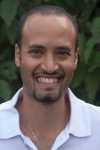Author Interviews, JAMA, Ophthalmology, Technology / 02.06.2015
Smartphone-Based Vision Test For Community-Based Evaluations
 MedicalResearch.com Interview with:
Andrew Bastawrous, MRCOphth
International Centre for Eye Health, Clinical Research Department
London School of Hygiene and Tropical Medicine (LSHTM), London, England
Medical Research: What is the background for this study? What are the main findings?
Dr. Bastawrous: As part of my PhD with the International Centre for Eye Health at the London School of Hygiene & Tropical Medicine, I led the follow-up of a major cohort study of eye disease [http://www.biomedcentral.com/1471-2415/14/60] following up 5,000 people in 100 different locations across the Great Rift Valley in Kenya. It was really challenging, two-thirds of the locations had no road access or electricity and we were carrying over £100,000 worth of fragile eye equipment and a team of 15 people in two vans to be able to carry out high quality measures of eye disease and answer some important questions for planning eye services.
What we found was that in the most difficult to reach locations we would find lots of people waiting to see us who had been unnecessarily blind from preventable/treatable diseases. Despite the locations having no roads, electricity and often no water, nearly all the locations had good phone signal.
Together with a brilliant team of developers, engineers and ophthalmologists we developed a suite of smartphone based tests to see if we could replace some of the standard equipment being used, in the hope that we could make it more portable and easier for non-specialists to perform so that ultimately the most high-risk individuals could be reached and treated.
This paper describes one of those tests, the visual acuity test - Peek Acuity.
Our field workers tested patients in their own homes using a standard card based Snellen chart (the type of vision test most non-ophthalmic healthcare workers are familiar with and has been the most commonly used acuity test for several decades now) and Peek Acuity. The same tests were repeated by the same healthcare worker in the clinic the following day as well as a reference standard vision test (LogMAR ETDRS) performed by an eye trained clinical officer.
This allowed us to perform "test re-test", a measure of a tests repeatability. i.e. if you have the same test at two separate time points we would expect the the measures to be very close. We found that for both Peek Acuity and Snellen they were highly repeatable. An advantage of Snellen is the speed of the test, Peek Acuity came out slightly quicker overall. We also found when compared to the reference standard test, Peek Acuity was highly comparable and within a clinically acceptable limit of difference.
(more…)
MedicalResearch.com Interview with:
Andrew Bastawrous, MRCOphth
International Centre for Eye Health, Clinical Research Department
London School of Hygiene and Tropical Medicine (LSHTM), London, England
Medical Research: What is the background for this study? What are the main findings?
Dr. Bastawrous: As part of my PhD with the International Centre for Eye Health at the London School of Hygiene & Tropical Medicine, I led the follow-up of a major cohort study of eye disease [http://www.biomedcentral.com/1471-2415/14/60] following up 5,000 people in 100 different locations across the Great Rift Valley in Kenya. It was really challenging, two-thirds of the locations had no road access or electricity and we were carrying over £100,000 worth of fragile eye equipment and a team of 15 people in two vans to be able to carry out high quality measures of eye disease and answer some important questions for planning eye services.
What we found was that in the most difficult to reach locations we would find lots of people waiting to see us who had been unnecessarily blind from preventable/treatable diseases. Despite the locations having no roads, electricity and often no water, nearly all the locations had good phone signal.
Together with a brilliant team of developers, engineers and ophthalmologists we developed a suite of smartphone based tests to see if we could replace some of the standard equipment being used, in the hope that we could make it more portable and easier for non-specialists to perform so that ultimately the most high-risk individuals could be reached and treated.
This paper describes one of those tests, the visual acuity test - Peek Acuity.
Our field workers tested patients in their own homes using a standard card based Snellen chart (the type of vision test most non-ophthalmic healthcare workers are familiar with and has been the most commonly used acuity test for several decades now) and Peek Acuity. The same tests were repeated by the same healthcare worker in the clinic the following day as well as a reference standard vision test (LogMAR ETDRS) performed by an eye trained clinical officer.
This allowed us to perform "test re-test", a measure of a tests repeatability. i.e. if you have the same test at two separate time points we would expect the the measures to be very close. We found that for both Peek Acuity and Snellen they were highly repeatable. An advantage of Snellen is the speed of the test, Peek Acuity came out slightly quicker overall. We also found when compared to the reference standard test, Peek Acuity was highly comparable and within a clinically acceptable limit of difference.
(more…)